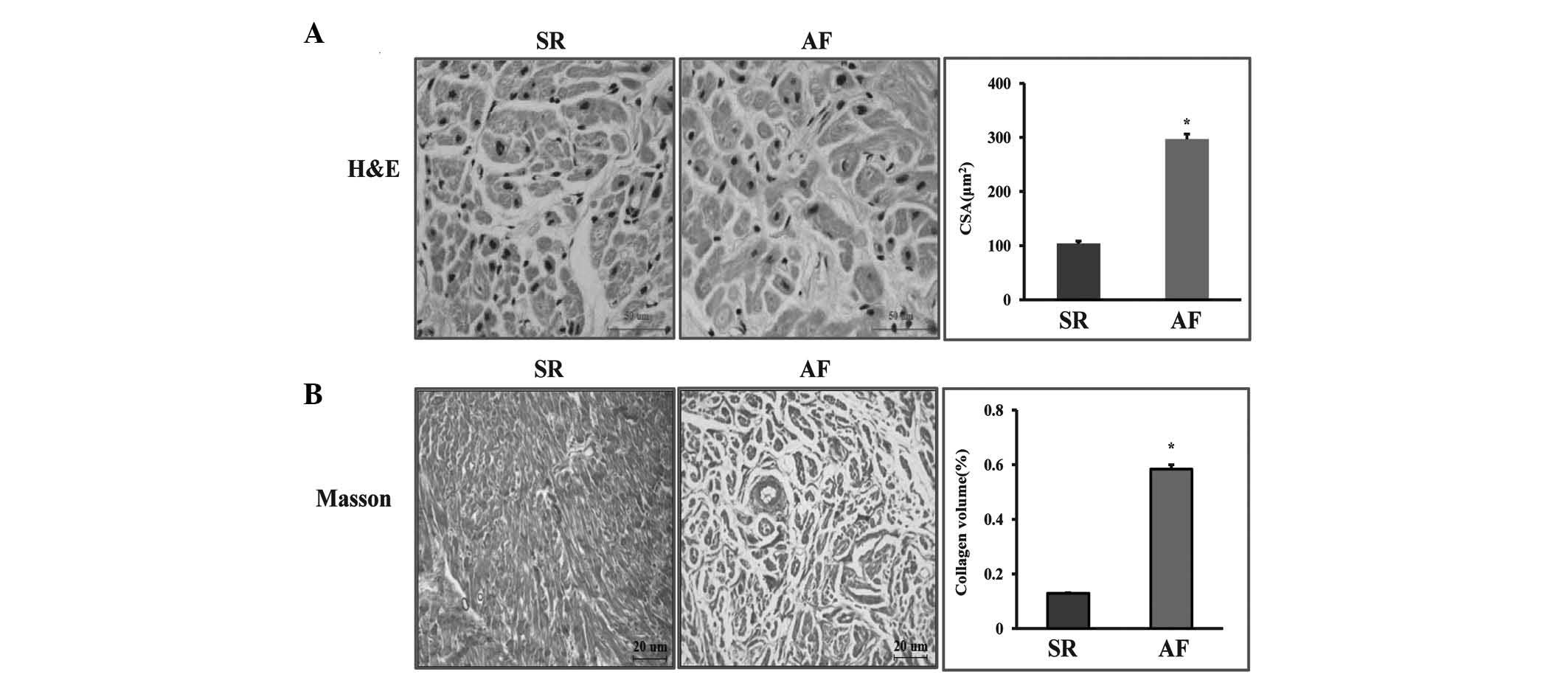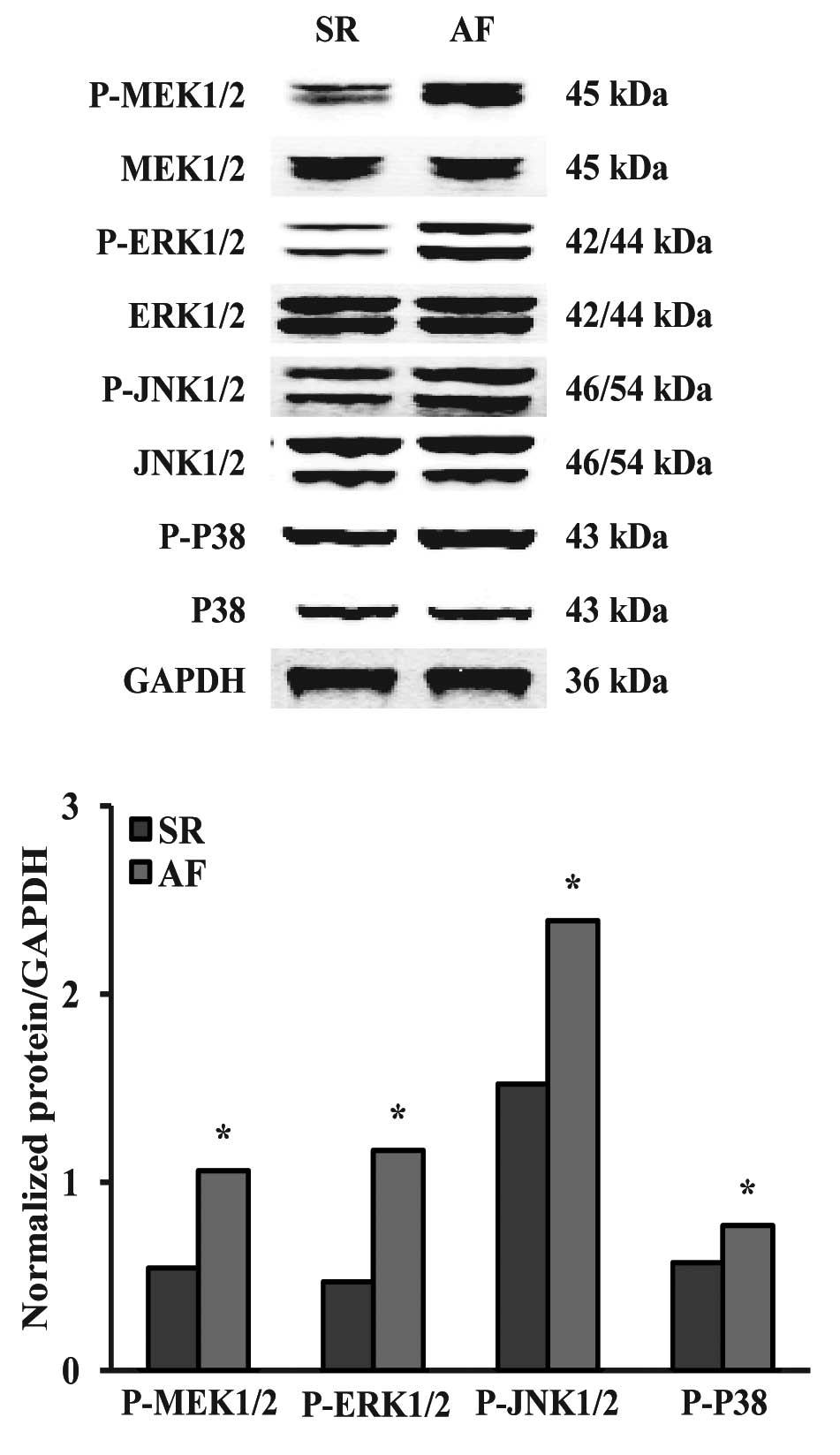|
1.
|
Cao X, Wang S, Jiang L, Liu L, Huang H and
Lu Z: Embolic events in 93 elderly Chinese patients with atrial
fibrillation. Chin Med J (Engl). 113:320–323. 2000.PubMed/NCBI
|
|
2.
|
Man J and Marchlinski FE: Atrial
fibrillation ablation and heart failure. Curr Cardiol Rep.
14:571–576. 2012. View Article : Google Scholar : PubMed/NCBI
|
|
3.
|
Ollivier R, Donal E, Veillard D, Pavin D,
Hamonic S, Daubert JC and Mabo P: Early and late cardiac
ventricular reverse remodeling after catheter ablation for lone
paroxysmal atrial fibrillation. Ann Cardiol Angeiol (Paris).
60:1–8. 2011. View Article : Google Scholar
|
|
4.
|
Efremidis M, Sideris A, Xydonas S, Letsas
KP, Alexanian IP, Manolatos D, Mihas CC, Filippatos GS and Kardaras
F: Ablation of atrial fibrillation in patients with heart failure:
reversal of atrial and ventricular remodelling. Hellenic J Cardiol.
49:19–25. 2008.PubMed/NCBI
|
|
5.
|
Olasinska-Wisniewska A, Mularek-Kubzdela
T, Grajek S, Marszalek A, Sarnowski W, Jemielity M, Seniuk W,
Lesiak M, Prech M and Podzerek T: Impact of atrial remodeling on
heart rhythm after radiofrequency ablation and mitral valve
operations. Ann Thorac Surg. 93:1449–1455. 2012. View Article : Google Scholar : PubMed/NCBI
|
|
6.
|
de Oliveira IM, Oliveira BD, Scanavacca MI
and Gutierrez PS: Fibrosis, myocardial crossings, disconnections,
abrupt turns, and epicardial reflections: do they play an actual
role in human permanent atrial fibrillation? A controlled necropsy
study. Cardiovasc Pathol. 22:65–69. 2013.
|
|
7.
|
Platonov PG, Mitrofanova LB, Orshanskaya V
and Ho SY: Structural abnormalities in atrial walls are associated
with presence and persistency of atrial fibrillation but not with
age. J Am Coll Cardiol. 58:2225–2232. 2011. View Article : Google Scholar : PubMed/NCBI
|
|
8.
|
Kim SJ, Choisy SC, Barman P, Zhang H,
Hancox JC, Jones SA and James AF: Atrial remodeling and the
substrate for atrial fibrillation in rat hearts with elevated
afterload. Circ Arrhythm Electrophysiol. 4:761–769. 2011.
View Article : Google Scholar : PubMed/NCBI
|
|
9.
|
Cha TJ, Ehrlich JR, Zhang L, Shi YF,
Tardif JC, Leung TK and Nattel S: Dissociation between ionic
remodeling and ability to sustain atrial fibrillation during
recovery from experimental congestive heart failure. Circulation.
109:412–418. 2004. View Article : Google Scholar
|
|
10.
|
Hong CS, Cho MC, Kwak YG, Song CH, Lee YH,
Lim JS, Kwon YK, Chae SW and Kim DH: Cardiac remodeling and atrial
fibrillation in transgenic mice overexpressing junctin. FASEB J.
16:1310–1312. 2002.PubMed/NCBI
|
|
11.
|
John B, Stiles MK, Kuklik P, et al:
Electrical remodelling of the left and right atria due to rheumatic
mitral stenosis. Eur Heart J. 29:2234–2243. 2008. View Article : Google Scholar : PubMed/NCBI
|
|
12.
|
de Groot NM, Zeppenfeld K, Wijffels MC,
Chan WK, Blom NA, Van der Wall EE and Schalij MJ: Ablation of focal
atrial arrhythmia in patients with congenital heart defects after
surgery: role of circumscribed areas with heterogeneous conduction.
Heart Rhythm. 3:526–535. 2006.PubMed/NCBI
|
|
13.
|
Ishikawa H, Jo JI and Tabata Y: Liver
anti-fibrosis therapy with mesenchymal stem cells secreting
hepatocyte growth factor. J Biomater Sci Polym Ed. 23:2259–2272.
2012.PubMed/NCBI
|
|
14.
|
Okunishi K, Dohi M, Nakagome K, Tanaka R,
Mizuno S, Matsumoto K, Miyazaki J, Nakamura T and Yamamoto K: A
novel role of hepatocyte growth factor as an immune regulator
through suppressing dendritic cell function. J Immunol.
175:4745–4753. 2005. View Article : Google Scholar : PubMed/NCBI
|
|
15.
|
Iwata K, Sawa Y, Kitagawa-Sakakida S,
Kawaguchi N, Matsuura N, Nakamura T and Matsuda H: Gene
transfection of hepatocyte growth factor attenuates the progression
of cardiac remodeling in the hypertrophied heart. J Thorac
Cardiovasc Surg. 130:719–725. 2005. View Article : Google Scholar : PubMed/NCBI
|
|
16.
|
Cecchi F, Rabe DC and Bottaro DP:
Targeting the HGF/Met signaling pathway in cancer therapy. Expert
Opin Ther Targets. 16:553–572. 2012. View Article : Google Scholar : PubMed/NCBI
|
|
17.
|
Trusolino L, Bertotti A and Comoglio PM:
MET signalling: principles and functions in development, organ
regeneration and cancer. Nat Rev Mol Cell Biol. 11:834–848. 2010.
View Article : Google Scholar : PubMed/NCBI
|
|
18.
|
Faletto DL, Kaplan DR, Halverson DO, Rosen
EM and Vande Woude GF: Signal transduction in c-met mediated
motogenesis. EXS. 65:107–130. 1993.PubMed/NCBI
|
|
19.
|
Zhang YW and Vande Woude GF: HGF/SF-met
signaling in the control of branching morphogenesis and invasion. J
Cell Biochem. 88:408–417. 2003. View Article : Google Scholar : PubMed/NCBI
|
|
20.
|
Ornitz DM: FGFs, heparan sulfate and
FGFRs: complex interactions essential for development. Bioessays.
22:108–112. 2000. View Article : Google Scholar : PubMed/NCBI
|
|
21.
|
Tan AY and Zimetbaum P: Atrial
fibrillation and atrial fibrosis. J Cardiovasc Pharmacol.
57:625–629. 2011. View Article : Google Scholar : PubMed/NCBI
|
|
22.
|
Xing XQ, Xu J, Su H and Lu YW: Association
between myocardial connexin 40 and 45 expression and myocardial
fibrosis in the rapid atrial pacing canine model. Zhonghua Xin Xue
Guan Bing Za Zhi. 39:176–180. 2011.(In Chinese).
|
|
23.
|
Chen YQ, Wang L, Su X, Tao L and Chen XF:
Calpain-I, calpastatin, caspase-3 and apoptosis in the human left
atrium in rheumatic atrial fibrillation. Zhonghua Xin Xue Guan Bing
Za Zhi. 34:303–307. 2006.(In Chinese).
|
|
24.
|
Flamme I, Schulze-Osthoff K and Jacob HJ:
Mitogenic activity of chicken chorioallantoic fluid is temporally
correlated to vascular growth in the chorioallantoic membrane and
related to fibroblast growth factors. Development. 111:683–690.
1991.
|
|
25.
|
Toledo RN, Borin A, Cruz OL, Ho PL, Testa
JR and Fukuda Y: The action of topical basic fibroblast growth
factor in facial nerve regeneration. Otol Neurotol. 31:498–505.
2010. View Article : Google Scholar : PubMed/NCBI
|
|
26.
|
Abe M, Yokoyama Y and Ishikawa O: A
possible mechanism of basic fibroblast growth factor-promoted
scarless wound healing: the induction of myofibroblast apoptosis.
Eur J Dermatol. 22:46–53. 2012.PubMed/NCBI
|
|
27.
|
Felix AS, Edwards RP, Stone RA, Chivukula
M, Parwani AV, Bowser R, Linkov F and Weissfeld JL: Associations
between hepatocyte growth factor, c-Met, and basic fibroblast
growth factor and survival in endometrial cancer patients. Br J
Cancer. 106:2004–2009. 2012. View Article : Google Scholar : PubMed/NCBI
|
|
28.
|
Virag JA, Rolle ML, Reece J, Hardouin S,
Feigl EO and Murry CE: Fibroblast growth factor-2 regulates
myocardial infarct repair: effects on cell proliferation, scar
contraction, and ventricular function. Am J Pathol. 171:1431–1440.
2007. View Article : Google Scholar : PubMed/NCBI
|
|
29.
|
Taniyama Y, Morishita R, Aoki M, Hiraoka
K, Yamasaki K, Hashiya N, Matsumoto K, Nakamura T, Kaneda Y and
Ogihara T: Angiogenesis and antifibrotic action by hepatocyte
growth factor in cardiomyopathy. Hypertension. 40:47–53. 2002.
View Article : Google Scholar : PubMed/NCBI
|
|
30.
|
Inoue T, Okada H, Kobayashi T, Watanabe Y,
Kanno Y, Kopp JB, Nishida T, Takigawa M, Ueno M, Nakamura T and
Suzuki H: Hepatocyte growth factor counteracts transforming growth
factor-beta1, through attenuation of connective tissue growth
factor induction, and prevents renal fibrogenesis in 5/6
nephrectomized mice. FASEB J. 17:268–270. 2003.
|
|
31.
|
Jun EJ, Kim HS and Kim YH: Role of
HGF/c-Met in serum-starved ARPE-19 cells. Korean J Ophthalmol.
21:244–250. 2007. View Article : Google Scholar : PubMed/NCBI
|
|
32.
|
Gu J, Liu X, Wang QX, Tan HW, Guo M, Jiang
WF and Zhou L: Angiotensin II increases CTGF expression via
MAPKs/TGF-β1/TRAF6 pathway in atrial fibroblasts. Exp Cell Res.
318:2105–2115. 2012.PubMed/NCBI
|
|
33.
|
Ambrosino C, Iwata T, Scafoglio C,
Mallardo M, Klein R and Nebreda AR: TEF-1 and C/EBPbeta are major
p38alpha MAPK-regulated transcription factors in proliferating
cardiomyocytes. Biochem J. 396:163–172. 2006. View Article : Google Scholar : PubMed/NCBI
|
|
34.
|
Nagai Y, Miyata K, Sun GP, Rahman M,
Kimura S, Miyatake A, Kiyomoto H, Kohno M, Abe Y, Yoshizumi M and
Nishiyama A: Aldosterone stimulates collagen gene expression and
synthesis via activation of ERK1/2 in rat renal fibroblasts.
Hypertension. 46:1039–1045. 2005. View Article : Google Scholar : PubMed/NCBI
|
|
35.
|
Lu Z, Ding L, Hong H, Hoggard J, Lu Q and
Chen YH: Claudin-7 inhibits human lung cancer cell migration and
invasion through ERK/MAPK signaling pathway. Exp Cell Res.
317:1935–1946. 2011. View Article : Google Scholar : PubMed/NCBI
|
|
36.
|
Cohen M, Marchand-Adam S, Lecon-Malas V,
Marchal-Somme J, Boutten A, Durand G, Crestani B and Dehoux M: HGF
synthesis in human lung fibroblasts is regulated by oncostatin M.
Am J Physiol Lung Cell Mol Physiol. 290:L1097–L1103. 2006.
View Article : Google Scholar : PubMed/NCBI
|
|
37.
|
Yang H, Xia Y, Lu SQ, Soong TW and Feng
ZW: Basic fibroblast growth factor-induced neuronal differentiation
of mouse bone marrow stromal cells requires FGFR-1, MAPK/ERK, and
transcription factor AP-1. J Biol Chem. 283:5287–5295. 2008.
View Article : Google Scholar
|
|
38.
|
Muddasani P, Norman JC, Ellman M, van
Wijnen AJ and Im HJ: Basic fibroblast growth factor activates the
MAPK and NFkappaB pathways that converge on Elk-1 to control
production of matrix metalloproteinase-13 by human adult articular
chondrocytes. J Biol Chem. 282:31409–31421. 2007.
|













